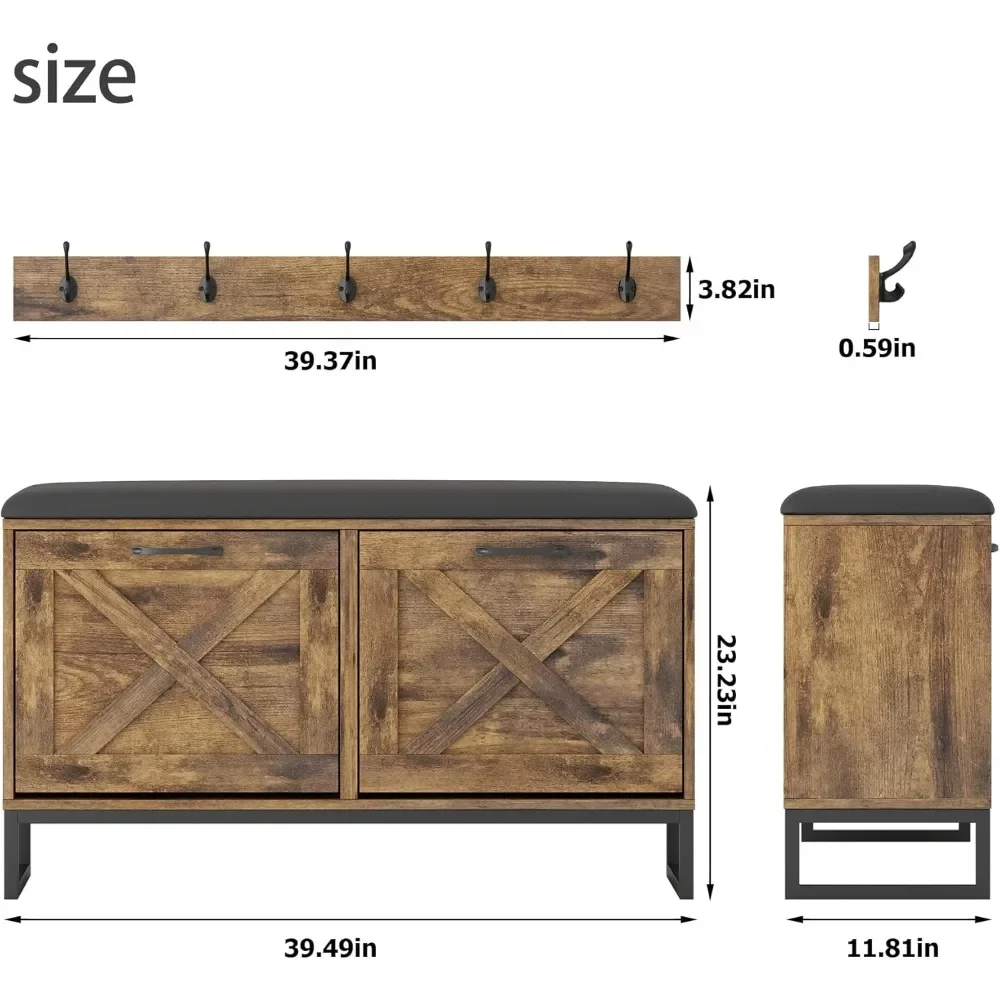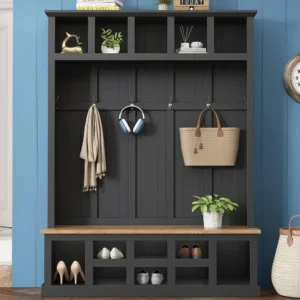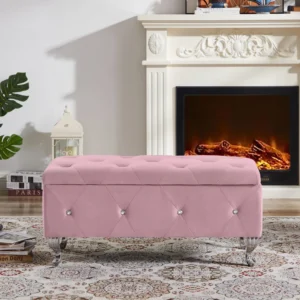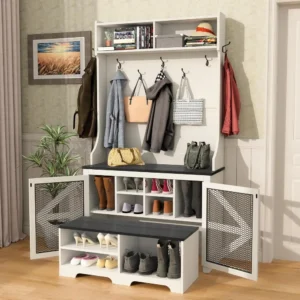Walking into a small entryway can feel like a daily challenge. With just 8-10 square feet of space in most modern homes, finding room for essential items while maintaining a welcoming atmosphere seems nearly impossible. This is where corner benches come to the rescue, offering a clever way to maximize functionality without sacrificing style.
Corner benches transform awkward, often unused corners into practical spaces that serve multiple purposes. They provide convenient seating for putting on shoes, offer storage solutions for everyday items, and create a designated area that prevents clutter from spreading throughout your home.
In this guide, we’ll explore how to select the perfect corner bench for your small entryway, discover styling tips that enhance your space rather than overwhelm it, and learn organization strategies that keep your entrance looking its best. Whether you’re dealing with an ultra-compact apartment entrance or simply want to make better use of a modest foyer, these space-maximizing solutions can dramatically improve both the function and appearance of your entryway.
The right corner bench does more than just fill space—it transforms entryway space-saving benches into beautiful, functional areas that set the tone for your entire home. Let’s discover how to organize small entryway bench spaces effectively, even when square footage is at a premium.
Why Corner Benches Are Perfect for Small Entryways
When space is limited, every square inch matters. Corner benches excel in small entryways for several compelling reasons that make them superior to traditional straight benches or other furniture options.
First and foremost, corner benches utilize typically wasted space. Those awkward corners that often remain empty or collect random items become functional areas that serve a purpose. By fitting snugly into these corners, these specialized benches can save up to 40% more floor space compared to traditional straight benches positioned against a single wall.
The multi-functionality of corner benches is another significant advantage:
- Dual-purpose design: Provides both seating and storage in a single piece
- Designated drop zone: Creates a specific place for keys, mail, and everyday items
- Circulation enhancement: Preserves precious walkway clearance by tucking into corners
- Visual organization: Makes the entire entryway appear more intentional and put-together
Most importantly, corner benches prevent your entryway from feeling cramped. By positioning furniture in corners rather than along walkways, you maintain open paths through your home, creating an impression of spaciousness even in tight quarters.
For homeowners looking to optimize their entryways, our corner entryway bench collection offers specifically designed solutions that maximize function while minimizing footprint.
How to Measure Your Small Entryway for the Perfect Corner Bench
Finding the right-sized corner bench begins with accurate measurements. Follow these steps to ensure your new furniture fits perfectly:
Measure corner depth and wall lengths: Start at the corner and measure outward along both walls to determine how much space you have available on each side. Remember to account for any wall irregularities or moldings.
Account for door swing clearance: Measure the arc your door creates when opening. Allow a minimum of 30 inches (76 cm) clearance for comfortable movement—this is essential for preventing awkward squeezing past furniture.
Check ceiling height: If you’re considering a bench with vertical storage components, measure floor-to-ceiling height to ensure proper fit.
Visualize the footprint: Use painter’s tape to outline the potential bench dimensions directly on your floor. This simple step helps you visualize traffic flow and prevents costly sizing mistakes.
Common measurement mistakes to avoid:
* Forgetting to account for baseboard heaters or air vents
* Neglecting to measure the widest part of the bench (sometimes the seat overhangs the base)
* Ignoring minimum walkway clearances (aim for at least 36 inches/91 cm)
* Measuring only one wall and assuming both are equal length
Taking accurate measurements is especially important when selecting best small benches for entryways since even small miscalculations can make a big difference in tight spaces.
Types of Corner Benches Ideal for Small Spaces
Different corner bench designs offer unique advantages for small entryways. Understanding these variations helps you select the perfect fit for your specific space constraints and needs.
L-Shaped Benches
L-shaped benches follow the natural corner configuration, providing maximum seating along both walls. These typically extend 2-3 feet (60-90 cm) along each wall.
Pros:
* Offers the most seating capacity
* Creates a cohesive, built-in look
* Often includes storage in both sections
Cons:
* Requires sufficient wall space on both sides
* Less flexible for rearranging
Triangular/Wedge Benches
These true corner-fitting solutions are shaped specifically to fit into corners with minimal extension along walls—usually under 24 inches (60 cm) on each side.
Pros:
* Takes up minimal floor space
* Perfect for extremely tight entryways
* Often includes clever storage solutions
Cons:
* Limited seating area
* Typically seats only one person
Floating Corner Benches
Mounted directly to the wall with open space underneath, these create visual spaciousness in tight areas.
Pros:
* Creates perception of more floor space
* Easier floor cleaning
* Modern, minimalist appearance
Cons:
* Usually limited storage capacity
* Requires solid wall construction for support
For homeowners seeking versatile entryway solutions, our entryway hall tree options include corner configurations that combine seating with vertical storage—perfect for maximizing limited square footage.
Essential Storage Features for Small Entryway Corner Benches
When space is limited, your corner bench needs to work harder by incorporating smart storage solutions. Here are the most effective storage features to look for:
Hidden Storage Compartments
Lift-top designs with concealed storage underneath the seat keep items accessible but out of sight. These compartments are ideal for seasonal items, rarely used accessories, or spare footwear.
Open vs. Closed Shoe Storage
| Storage Type | Best For | Considerations |
|---|---|---|
| Open Shelving | Quick access, frequently used shoes | Visible clutter, limited to 4-6 pairs |
| Closed Cabinets | Neater appearance, more shoes | Takes longer to access, slightly larger footprint |
| Cubby Systems | Organized, separated storage | Each family member can have a designated space |
Drawer Systems
Shallow drawers work beautifully for smaller items like gloves, scarves, or dog leashes. They prevent these necessities from becoming tangled or lost while maintaining a clean appearance.
Vertical Storage Integration
The most space-efficient designs incorporate vertical elements like hooks, racks, or small shelves above the bench. This approach maximizes your storage capacity without increasing the bench’s footprint.
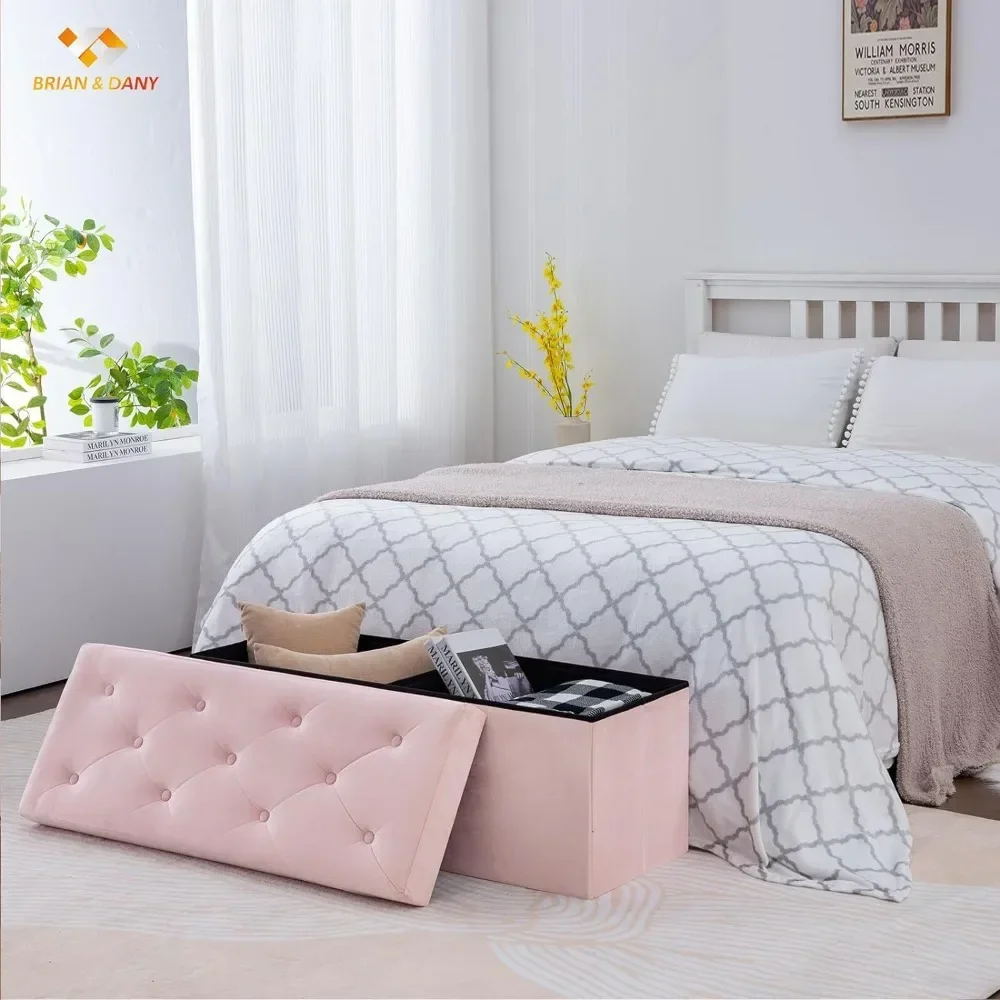
Finding the perfect balance of storage types ensures your small entryway remains functional without feeling crowded. Explore our entryway bench storage collection for options specifically designed to maximize organization in minimal space.
Best Materials for Durable, High-Traffic Entryway Corner Benches
Your entryway bench will face daily use and abuse—from wet shoes and heavy bags to constant sitting and standing. Selecting the right material ensures your investment lasts for years while maintaining its appearance.
Solid Wood Options
Hardwoods like oak and maple offer exceptional durability with natural beauty. These materials withstand heavy use and resist dents better than softer woods. While more expensive initially, their 15+ year average lifespan makes them cost-effective long-term investments.
Engineered Woods
Modern MDF and particle board options with proper sealing provide budget-friendly alternatives. Look for moisture-resistant finishes and quality construction, particularly around joints and stress points. These typically last 5-7 years with proper care.
Metal Frames
Steel or wrought iron frames paired with wood or upholstered seats create sturdy, contemporary designs. Metal components resist damage but may require occasional touch-ups to prevent rust, especially in humid entryways.
Performance Fabrics
For upholstered options, look for stain-resistant performance fabrics with high “double rub” ratings (30,000+ is ideal). Materials like Sunbrella, Crypton, or similar performance textiles resist staining, fading, and wear.
When selecting materials, consider your specific entryway conditions. Homes with pets or children might benefit from the scratch resistance of metal, while those in humid climates should prioritize moisture-resistant finishes.
For more creative ways to enhance your entrance, our space-saving entryway ideas provide additional solutions that complement your corner bench while maximizing limited square footage.
Design Styles That Work Best in Limited Entryway Spaces
The right design style can make a small entryway appear more spacious while creating a welcoming atmosphere. Here are the most effective approaches for tight spaces:
Minimalist Designs
Clean lines and uncluttered surfaces visually expand your space. Look for benches with simple silhouettes and hidden storage that maintains the sleek appearance. These pieces typically feature matte finishes in neutral tones with minimal ornamentation.
Scandinavian Simplicity
Light woods, pale colors, and functional beauty characterize this space-enhancing style. Scandinavian designs often incorporate natural materials with thoughtful details, creating pieces that feel airy rather than heavy.
Space-Enhancing Elements
Certain design features make any bench feel lighter in a small space:
* Raised legs instead of solid bases create visual breathing room
* Light or natural finishes reflect more light than dark colors
* Glass or transparent components reduce visual weight
* Rounded corners prevent awkward navigation around sharp edges
Matching Existing Décor
Your corner bench should complement your home’s overall style. For traditional homes, look for benches with classic profiles and warm wood tones. Contemporary spaces benefit from clean lines and mixed materials like wood with metal accents.
The right design creates visual cohesion between your entryway and the rest of your home, making the transition space feel intentional rather than an afterthought. Browse our small entryway bench collection for pieces specifically sized and styled for limited spaces.
Our Top Picks: Best Corner Benches for Compact Entryways
After extensive research and customer feedback, we’ve identified the best corner bench solutions for specific small-space challenges. Each recommendation balances dimensions, storage efficiency, quality construction, and style.
Best for Ultra-Compact Spaces (Under 3 feet/0.9 meters)
Compact corner benches with triangular designs excel when space is extremely limited. Look for models under 30 inches in width with built-in shoe storage underneath. The best designs feature a small footprint but still accommodate 1-2 seated adults.
Best Storage-to-Footprint Ratio
Models combining under-seat storage with vertical components make the most of limited square footage. The most efficient designs incorporate hidden compartments, shoe shelves, and hooks in a single unit while extending less than 42 inches (107 cm) along each wall.
Best for Awkward Corner Angles
For entryways with non-standard corners (not 90 degrees), adjustable or modular units offer customization possibilities. These feature separate components that can be arranged to accommodate unusual angles while maintaining functionality.
Most Versatile for Different Layouts
Lightweight, movable corner benches that don’t require wall attachment provide flexibility for changing needs. The most adaptable models feature removable cushions, modular storage components, and durable casters for easy repositioning.
Budget-Friendly Options
Quality corner solutions are available under $300 that combine durability with smart design. These typically feature engineered wood construction with laminate finishes that resist moisture and scratches.
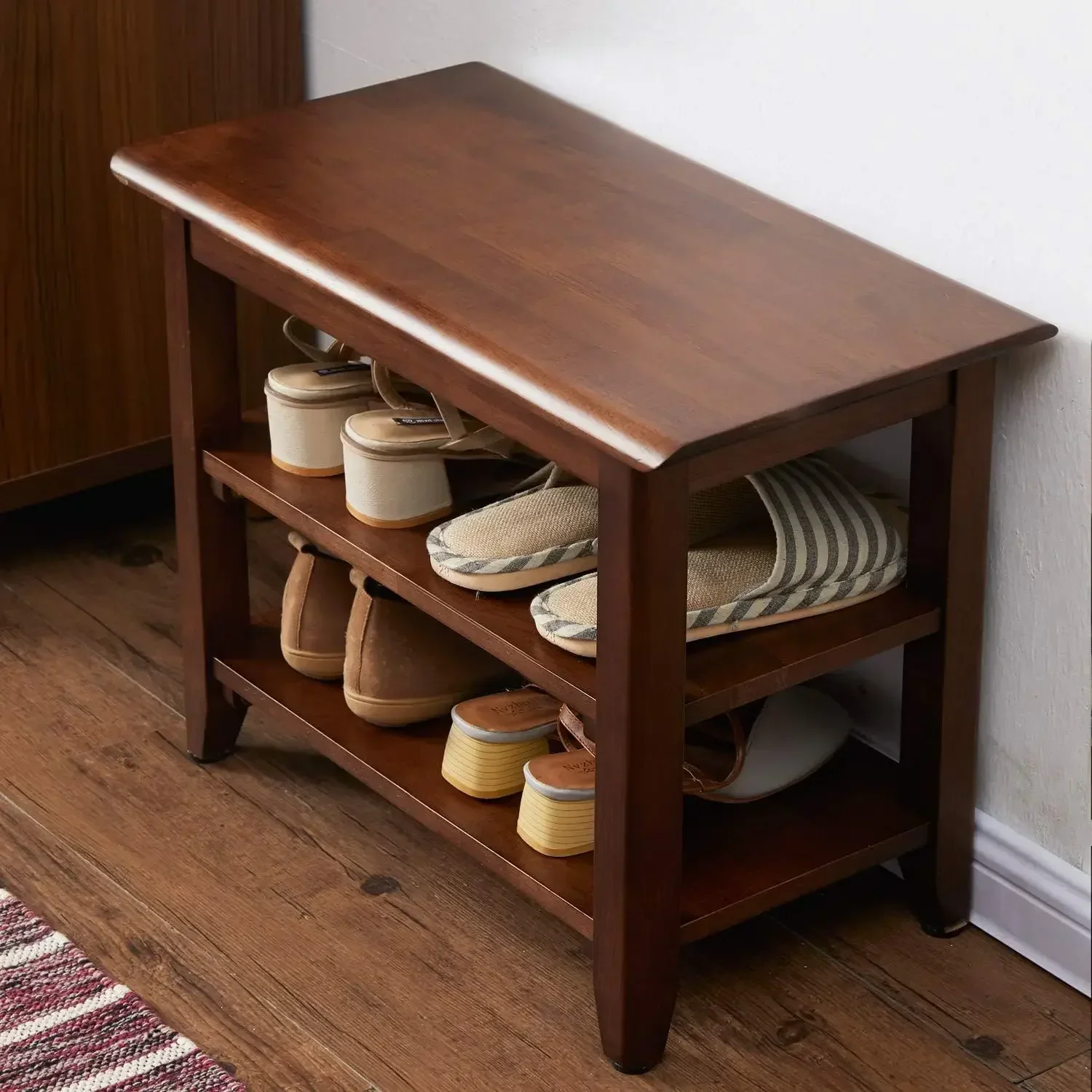
For maximum space efficiency in small entryways, our corner hall tree collection combines bench seating with vertical storage for coats, bags, and accessories—the ultimate all-in-one solution.
How to Style Your Corner Bench for Maximum Visual Appeal
Once you’ve selected the perfect corner bench, thoughtful styling transforms it from simple furniture to a design focal point. These approaches enhance your bench’s appearance without creating clutter:
Creating Visual Balance
Corner benches naturally create asymmetrical arrangements. Balance this by placing a taller element (like a plant or lamp) on the shorter side, or hang wall art that visually extends from the corner outward. This creates harmony without perfect symmetry.
Adding Textiles for Comfort and Style
Cushions and small pillows add both comfort and color. Select weather-appropriate fabrics—machine-washable cotton blends for muddy seasons, lighter linens for summer. Limit textiles to 1-2 pieces to prevent overcrowding.
Incorporating Seasonal Elements
Refresh your entryway’s appearance with simple seasonal adjustments:
* Spring: Light-colored cushions and small potted plants
* Summer: Natural textures like jute and rattan accessories
* Fall: Warmer tones and perhaps a small basket for gloves
* Winter: Additional lighting and more substantial textiles
Lighting Considerations
Proper lighting enhances both function and atmosphere. A small table lamp on the bench surface or well-placed wall sconces illuminate the area while creating warmth. Consider motion-activated options for convenience and energy efficiency.
For more inspiration on creating beautiful, functional entrances, our small modern entryway styling tips provide additional guidance tailored to limited spaces.
Smart Organization Strategies for Your Entryway Corner Bench
Even the best-designed corner bench requires thoughtful organization to maintain its functionality. These practical strategies keep your entryway tidy with minimal effort:
Daily Organization Habits
Establish simple 5-minute routines that prevent clutter accumulation:
* Empty pockets immediately when arriving home
* Return items to designated spots after each use
* Implement a “one in, one out” policy for items like shoes
* Quick wipe-down of frequently touched surfaces
Seasonal Rotation
Maximize limited storage by rotating seasonal items:
* Store off-season accessories in labeled containers elsewhere
* Keep only current-season items in prime accessibility spots
* Schedule regular “switch-over” days when seasons change
* Maintain a small “overflow” area for unexpected weather changes
Internal Organization Tools
Enhance your bench’s storage capacity with:
* Small bins or baskets for grouping similar items
* Drawer dividers for keeping small accessories separated
* Shoe organizers that maximize vertical space
* Labels for family members’ dedicated areas
Priority Placement
Position items based on frequency of use, with daily essentials in the most accessible spots and occasional items stored deeper or higher. This simple approach dramatically improves functionality without requiring complex systems.
For additional storage solutions specifically designed for corner configurations, our best corner benches for entry storage collection offers specialized options that maximize organization potential.
Complementary Pieces to Pair with Your Small-Space Corner Bench
The right supporting elements enhance your corner bench’s functionality without overwhelming your limited space. Consider these space-conscious additions:
Wall-Mounted Solutions
Vertical storage maximizes functionality without consuming floor space:
* Floating shelves (keeping depth under 8 inches/20 cm)
* Hook rails positioned at convenient heights for different users
* Small key holders or mail organizers mounted at eye level
Slim Umbrella Storage
Narrow umbrella stands with drip trays protect floors while containing wet items. Look for models under 8 inches (20 cm) in diameter that tuck neatly beside your bench.
Strategic Mirror Placement
Mirrors above or adjacent to corner benches serve dual purposes:
* Create the illusion of more space through reflection
* Provide a last-minute appearance check before leaving
* Position at heights appropriate for all household members
Appropriate Lighting
Wall-mounted sconces or small accent lights eliminate the need for table lamps that consume surface space. Look for fixtures extending less than 6 inches (15 cm) from the wall with adjustable brightness for different needs.
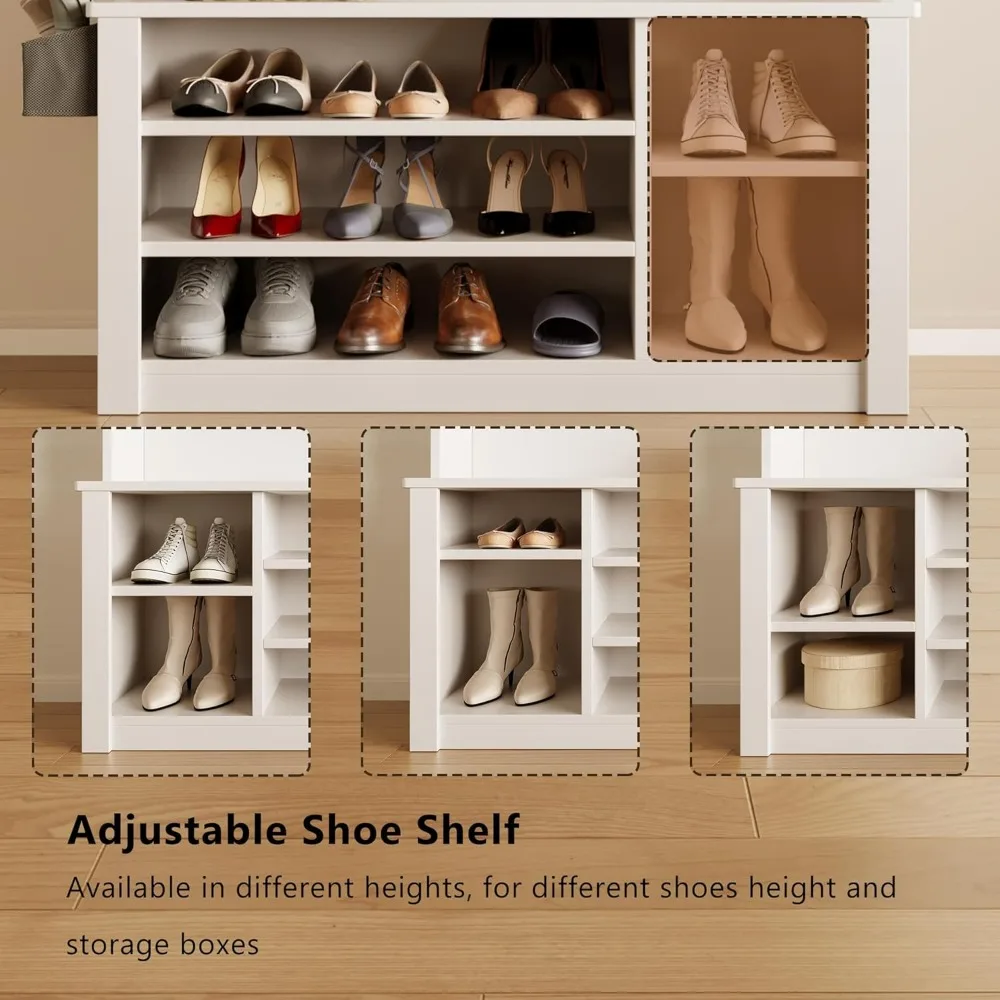
Coat Rack Shoe Bench, Corner Entryway Bench, Corner Hall Tree, Shoe Bench for Entryway
$313.58 Select options This product has multiple variants. The options may be chosen on the product pageCorner Entryway Bench, Entryway Bench with Cushion, Modern Entryway Bench, Shoe Bench for Entryway
$476.34 Select options This product has multiple variants. The options may be chosen on the product pageBench with Hooks and Storage, Entryway Hall Tree, Mudroom Bench with Cubbies, Mudroom Bench with Shoe Storage
$818.38 Select options This product has multiple variants. The options may be chosen on the product pageEntryway Coat Rack Bench, Entryway Hall Tree, Farmhouse Mudroom Bench, Mudroom Bench with Shoe Storage
$805.09 Select options This product has multiple variants. The options may be chosen on the product pageEntryway Bench with Cushion, Small Entryway Bench
$466.79 Select options This product has multiple variants. The options may be chosen on the product pageBench with Hooks and Storage, Entryway Coat Rack Bench, Entryway Hall Tree, Mudroom Bench with Shoe Storage, Mudroom Coat Rack Bench
$793.73 Select options This product has multiple variants. The options may be chosen on the product page
DIY Corner Bench Ideas for Budget-Conscious Homeowners
Creating your own custom corner bench allows perfect sizing for your unique space while potentially saving money. Consider these approachable projects based on your skill level:
Simple Construction Project
Materials: Pre-cut lumber, corner brackets, wood screws, paint or stain
Tools needed: Drill, saw, measuring tape, sanding tools
Difficulty: Moderate
Time estimate: Weekend project (8-10 hours)
Approximate cost: $75-150
This straightforward approach uses simple box construction with a hinged top for storage. The design can be customized to your exact corner dimensions.
Upcycling Opportunity
Materials: Two matching small benches or chairs, corner brackets, paint
Tools needed: Basic hand tools, sandpaper
Difficulty: Easy
Time estimate: 4-6 hours
Approximate cost: $30-50 (excluding furniture)
This clever solution repurposes existing furniture by connecting two pieces at a corner angle, creating an L-shaped arrangement that looks intentional rather than improvised.
Customizing Prefab Pieces
Materials: Ready-made storage cubes, wooden seat top, cushion
Tools needed: Screwdriver, measuring tape
Difficulty: Very easy
Time estimate: 2-3 hours
Approximate cost: $60-120
This beginner-friendly project combines manufactured storage cubes arranged in an L-shape with a custom-cut wooden top. The result looks polished while requiring minimal tools or expertise.
Frequently Asked Questions About Corner Benches for Small Entryways
What weight capacity can I expect from a corner bench?
Most quality corner benches support 250-400 pounds when properly constructed. Metal-framed models typically offer higher weight capacities than all-wood designs. Check manufacturer specifications, especially for benches that will accommodate multiple seated adults simultaneously.
Are corner benches difficult to assemble?
Assembly difficulty varies by design complexity. Simple models typically require 30-60 minutes with basic tools. More elaborate units with multiple storage components may take 1-2 hours. Most manufacturers provide detailed instructions, and many offer customer support for assembly questions.
How do I clean and maintain my entryway bench?
For wood finishes, use a soft cloth lightly dampened with furniture cleaner appropriate for your specific finish. Upholstered sections benefit from regular vacuuming with occasional spot cleaning using fabric-appropriate solutions. Metal components should be wiped down periodically to prevent buildup of fingerprints or dust.
What if my corner isn’t a perfect 90-degree angle?
For non-standard corners, consider adjustable or modular units that can accommodate various angles. Custom-built options provide the most precise fit for unusual spaces. Some manufacturers offer made-to-order services for challenging configurations.
How much should I expect to pay for a quality corner bench?
Quality corner benches for small entryways typically range from $150-$600 depending on materials, construction quality, and storage features. Basic models with minimal storage start around $150-200, while premium solid wood constructions with extensive storage solutions can reach $500-600.
Common Mistakes to Avoid When Choosing a Corner Bench
Preventing these common errors ensures your corner bench enhances rather than hinders your small entryway:
Oversizing Your Space
Problem: Selecting a bench too large for your available area creates awkward navigation and visual crowding.
Solution: Always measure your space carefully, accounting for door swing and traffic patterns. Use painter’s tape to mark the footprint before purchasing.
Prioritizing Style Over Function
Problem: Choosing a visually stunning bench that lacks practical storage creates ongoing organizational challenges.
Solution: Identify your specific storage needs first, then select from options that meet those requirements while complementing your aesthetic preferences.
Ignoring Door Clearance
Problem: Failing to account for door swing patterns creates daily frustration and potential damage.
Solution: Ensure at least 30 inches (76 cm) clearance from any open door to your bench. Consider door stop installation if needed to prevent contact.
Choosing Inappropriate Materials
Problem: Selecting materials unable to withstand entryway conditions leads to premature deterioration.
Solution: Choose materials appropriate for your specific conditions—moisture-resistant finishes for humid areas, durable fabrics for high-traffic homes, and scratch-resistant surfaces for households with pets.
Neglecting Future Needs
Problem: Purchasing based only on current household composition without considering future changes.
Solution: Select adaptable pieces that can evolve with your needs—modular components, adjustable features, and classic designs that work with various décor styles.
Creative Solutions for Extremely Challenging Entryway Corners
Some entryways present unique challenges that require innovative approaches. These solutions address specific difficult scenarios:
Non-Standard Corner Angles
For corners that aren’t 90 degrees, consider:
* Custom-built triangular benches fitted to your specific angle
* Modular pieces that can be configured to unusual shapes
* Floating corner shelves with a small bench positioned nearby
Ultra-Narrow Entryways (Under 3 feet/0.9 meters)
When width is severely limited:
* Wall-mounted flip-down seating that folds away when not in use
* Vertical storage with a small ottoman that slides underneath
* Corner shelf units with a narrow bench component
Working Around Architectural Features
When dealing with columns, partial walls, or other obstacles:
* Split-configuration benches that position storage on one side and seating on another
* Custom-notched designs that accommodate architectural elements
* Bench alternatives like wall-mounted shoe cabinets with a small stool
Rental-Friendly Options
When permanent installations aren’t possible:
* Freestanding corner units that don’t require wall attachment
* Modular pieces that can reconfigure for future spaces
* Tension-rod systems that create vertical storage without damaging walls
Summary: Transforming Your Small Entryway with the Perfect Corner Bench
The right corner bench transforms a small entryway from a cramped, cluttered space into a functional, welcoming entrance. By carefully considering measurements, storage needs, materials, and design style, you can select a piece that maximizes your limited space while enhancing your home’s first impression.
Remember that successful small spaces balance functionality with aesthetics. The perfect corner bench serves your practical needs while contributing to a cohesive design that reflects your personal style. By applying the selection criteria, organization strategies, and styling tips we’ve explored, you can create an entryway that feels spacious and intentional despite limited square footage.

